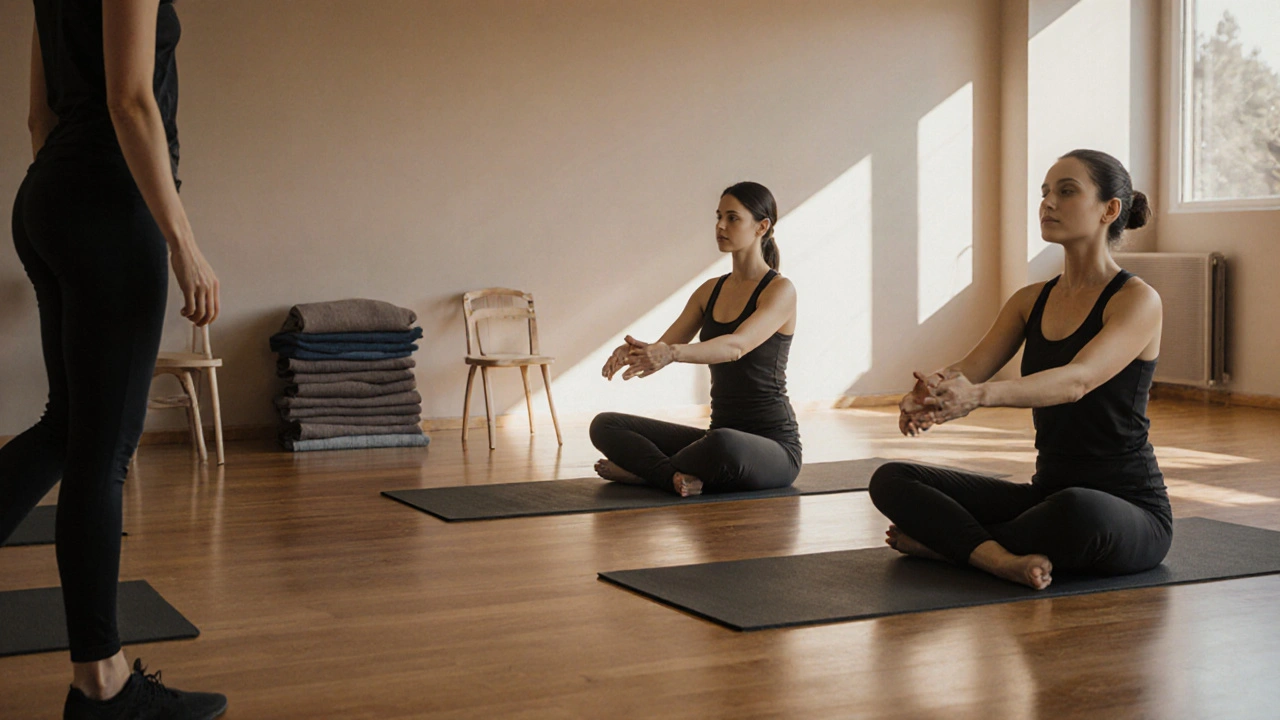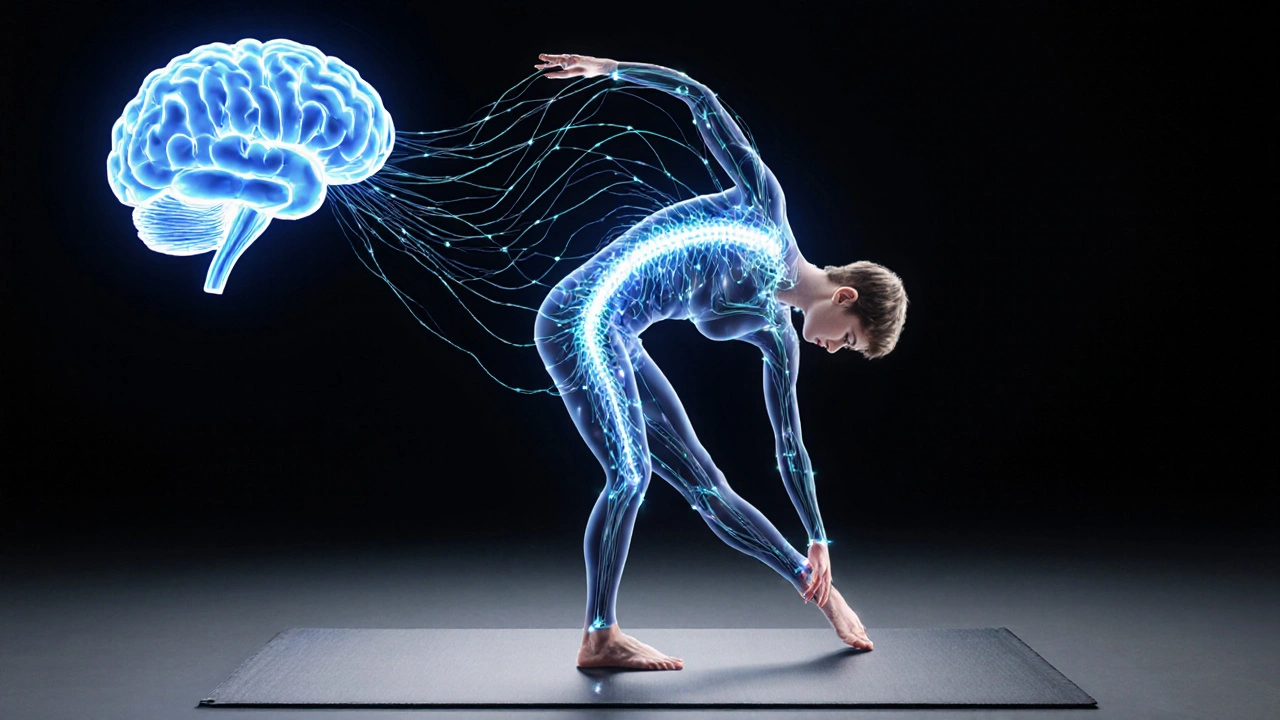Feldenkrais Training: Transform Your Fitness Routine
 Oct, 19 2025
Oct, 19 2025
Feldenkrais Practice Planner
Personalize Your Plan
Why This Matters
Feldenkrais training focuses on neuroplasticity and proprioception through gentle movement patterns. Your personalized plan helps integrate these principles into your existing routine without adding stress or intensity.
Your Personalized Feldenkrais Plan
Feldenkrais training is a movement‑education method that uses gentle, guided motions to improve body awareness and functional ability. If you’ve ever felt stuck in a plate‑of‑same‑old‑gym routine, the Feldenkrais approach offers a fresh way to move, feel better, and actually see performance gains without the typical high‑impact grind.
What Makes Feldenkrais Different from Traditional Fitness?
Most fitness programs focus on “how many reps” or “how heavy.” Feldenkrais flips that script. It asks, “How are you feeling while you move?” and “What patterns are hidden in everyday actions?” By tuning into subtle sensations, you unlock neuroplastic changes-your brain literally rewires to support smoother, more efficient movement.
Core Principles of Feldenkrai s
- Awareness through movement: Small, mindful explorations replace bulkier, repetitive sets.
- Gentle, non‑painful motion: The method never pushes the body past comfort, making it ideal for rehab or beginners.
- Neuro‑re‑education: Repeated, varied patterns teach the nervous system new pathways.
These ideas rest on three scientific concepts that the method actively uses.
Key Concepts Behind the Method
Neuroplasticity is the brain’s ability to reorganize itself in response to new experiences. Feldenkrais exploits this by offering countless micro‑variations of a movement, encouraging the brain to build richer motor maps.
Proprioception refers to the sense of body position and movement. By focusing attention on how joints, muscles, and breath feel, practitioners sharpen this internal GPS, leading to better balance and coordination.
Somatic learning emphasizes feeling before doing. This mindset reduces the risk of compensatory habits that often cause injury in conventional strength programs.
When you combine neuroplasticity, proprioception, and somatic learning, you get what many call functional movement-the ability to move efficiently in everyday life, not just within a gym setting.

Fitness Benefits You Can Actually Notice
- Improved flexibility without forced stretching. Tiny, repeated motions gently lengthen fibers over weeks.
- Greater core stability. By exploring how the spine aligns in various postures, the deep stabilizers become more active.
- Better balance and coordination. Heightened proprioceptive feedback translates to steadier steps on uneven terrain.
- Injury prevention. When you become aware of habitual tension, you can release it before it turns into pain.
- Enhanced strength efficiency. The nervous system learns to fire muscles in more optimal patterns, so you lift with less wasted effort.
All of these gains feel natural because they’re encoded in the brain, not just in sore muscles.
How to Bring Feldenkrais Into Your Fitness Routine
There are three common ways people start:
- Group classes: Look for “Awareness Through Movement” sessions-usually 60‑minute blocks that guide you through a series of explorations.
- One‑on‑one lessons: A certified practitioner can tailor movements to address specific issues like low‑back pain or shoulder tightness.
- DIY home practice: Simple videos or books (e.g., Moshe Feldenkrais’s "The Art of Somatic Education") let you repeat key sequences daily.
Start with a 10‑minute “warm‑up” of rolling shoulders, gentle neck circles, and slow hip rotations. Pay attention to any sensations-tightness, ease, or subtle shifts. Over time, add more complex patterns like reaching across the body while rotating the torso.
Tracking progress is easy: keep a short journal noting how a movement felt before and after a week of practice. You’ll often see improvements in range, comfort, or even how quickly you recover from a workout.
Feldenkrais vs. Yoga vs. Pilates: A Quick Comparison
| Aspect | Feldenkrais | Yoga | Pilates |
|---|---|---|---|
| Primary Goal | Increase body awareness & neuro‑re‑education | Combine breath, flexibility, and meditation | Core strengthening & controlled movement |
| Intensity | Low‑impact, adaptable to any fitness level | Varies-from gentle flow to vigorous power yoga | Generally moderate to high, focused on muscular endurance |
| Typical Session Length | 45-60 minutes (often seated or lying) | 30-90 minutes (standing, floor, props) | 45-60 minutes (mat or equipment) |
| Key Benefit for Athletes | Refined motor patterns, injury‑proofing | Improved flexibility, mental focus | Enhanced core power, spinal alignment |
| Learning Curve | Minimal - focus on sensation, not perfect form | Moderate - poses can be technically demanding | Moderate - requires precise control |
While yoga and Pilates each bring valuable tools to the fitness toolbox, Feldenkrais offers something uniquely subtle: a direct line to the brain’s wiring. Many athletes use it alongside their usual strength work to fine‑tune movement efficiency.

Practical Tips & Common Pitfalls
- Stay curious, not judgmental. Treat every sensation as data, not as right or wrong.
- Start slow. The method’s power lies in repetition of tiny variations; racing through lessons defeats the purpose.
- Avoid “hard‑core” expectations. You won’t see massive muscle size overnight, but you’ll notice smoother daily motions.
- Consistency beats intensity. Even 5 minutes a day builds stronger neural pathways than an occasional hour‑long session.
- Integrate with existing workouts. Use Feldenkrais as a warm‑up or cool‑down to prime the nervous system before weight training.
One common mistake is treating Feldenkrais like a regular class and pushing through discomfort. The method teaches you to listen, so if something feels off, modify or pause. Over time your body will self‑correct.
Key Takeaways
- Feldenkrais training is a brain‑focused movement education that boosts functional fitness.
- It improves flexibility, core stability, balance, and injury resistance without high impact.
- Neuroplasticity, proprioception, and somatic learning are the scientific pillars behind the method.
- Integrate it via classes, private lessons, or short home sessions to complement any workout plan.
- When paired with yoga or Pilates, Feldenkrais adds a unique neurological edge.
Frequently Asked Questions
Do I need any special equipment for Feldenkrais?
No. Most lessons are done on a mat, a chair, or even the floor. The focus is on your body’s internal feedback, not on props.
Can Feldenkrais help with chronic back pain?
Yes. By identifying and releasing habitual tension patterns, the method often reduces low‑back discomfort within a few weeks of regular practice.
How often should I practice?
Aim for short daily sessions-5 to 10 minutes. A weekly class plus a quick home routine works well for most people.
Is Feldenkrais suitable for athletes?
Absolutely. Many elite performers use it to fine‑tune motor patterns, improve coordination, and recover from overuse injuries.
Do I need a certified practitioner?
For beginners, a qualified teacher helps you feel the nuances. However, once you grasp the basics, you can safely explore many lessons on your own.
Ready to give your fitness routine a brain‑boost? Try a single Feldenkrais training class this month and notice how your everyday movements feel smoother, more coordinated, and less stressful.
